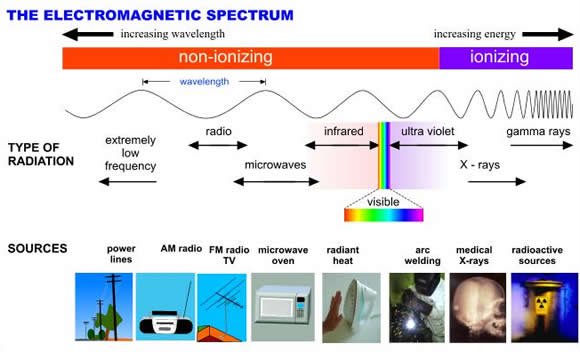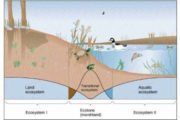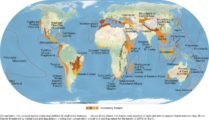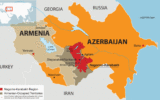
Radioactive Pollution: Ionizing & Non-Ionizing Radiation
Subscribe to Never Miss an Important Update! Assured Discounts on New Products!
Must Join PMF IAS Telegram Channel & PMF IAS History Telegram Channel
Last updated on April 17, 2024 7:34 PM
Radioactive Pollution
- Radioactive Pollution is defined as the increase in the natural radiation levels in the environment that pose a serious threat to humans and other life forms.
- Radioactive contamination is the deposition of or presence of radioactive substances on surfaces or within solids, liquids or gases (including the human body), where their presence is unintended or undesirable (International Atomic Energy Agency definition).
The use of nuclear energy has two very serious inherent problems:
- Accidental leakage, as occurred in the Three Mile Island, Chernobyl and Fukushima incidents and
- Safe disposal of radioactive wastes.
- At high doses, nuclear radiation is lethal, but at lower doses, it creates various disorders, the most frequent of all being cancer.
- Continued small dose exposure to nuclear radiation can cause childhood leukaemia, miscarriage, underweight babies, infant deaths, increased susceptibility to AIDS and other immune disorders.
Artificial Sources of Radioactive pollution
- Accidents in nuclear power plants and nuclear waste.
- Nuclear weapon testing and explosion (Nuclear fallout). The fall Out contains radioactive substances such as strontium-90, caesium-137, iodine-131, etc.
- Uranium mining and mining of other radioactive material like thorium (monazite is the ore of thorium).
- Radiation therapy and direct exposures to radiation for diagnostic purposes (e.g. X-rays), chemotherapy etc.
- The slow nuclear radiations can emanate from a variety of sources viz. nuclear reactors, laboratories, etc.
Natural Sources
- They include cosmic rays from space and terrestrial radiations from radio-nuclides present in earth’s crust such as radium-224, uranium-238, thorium-232, potassium-40, carbon-14, etc.
Ionizing and Non-Ionizing Radiation

- Radioactivity is a phenomenon of spontaneous emission of proton (alpha-particles), electrons (beta-particles) and gamma rays (short wave electromagnetic waves) due to the disintegration of atomic nuclei of some elements. These cause radioactive pollution.
- Radiations can be categorized into two groups namely the non-ionizing radiations and the ionising radiations.
Non-ionizing radiations
- Non-ionizing radiations are constituted by the electromagnetic waves at the longer wavelength of the spectrum ranging from near infra-red rays to radio waves (includes higher wavelength ultraviolet rays, microwaves).
- These waves have energies enough to excite the atoms and molecules of the medium through which they pass, causing them to vibrate faster but not strong enough to ionise them.
- They may damage eyes which may be caused by reflections from coastal sand, snow (snow blindness) directly looking towards the sun during an eclipse.
- They injure the cells of skin and blood capillaries producing blisters and reddening called sunburns.
In a microwave oven, the radiation causes water molecules in the cooking medium to vibrate faster and thus raising its temperature.
Ionising radiations
- Ionising radiations cause ionisation (one or more electrons are pealed out from the outer shells of an atom) of atoms and molecules of the medium through which they pass.
Ionisation is the process by which an atom or a molecule acquires a negative or positive charge by gaining or losing electrons to form ions, often in conjunction with other chemical changes.
- Electromagnetic radiations such as short wavelength ultraviolet radiations (UV), X-rays and gamma rays and energetic particles produced in nuclear processes, electrically charged particles like alpha and beta particles produced in radioactive decay and neutrons produced in nuclear fission, are highly damaging to living organisms.
- Electrically charged particles produced in the nuclear processes can have sufficient energy to knock electrons out of the atoms or molecules of the medium, thereby producing ions.
- The ions produced in water molecules, for example, can induce reactions that can break bonds in proteins and other important molecules.
- An example of this would be when a gamma ray passes through a cell, the water molecules near the DNA might be ionised and the ions might react with the DNA causing it to break.
- They can also cause chemical changes by breaking the chemical bonds, which can damage living tissues.
- Short range effects include burns, impaired metabolism, dead tissues and death of the organisms.
- Long range effects are mutations increased the incidence of tumours and cancer, shortening of life-span and developmental changes.
- Non-ionizing radiations affect only those components which absorb them and have low penetrability.
- Ionising radiations have high penetration power and cause breakage of macromolecules.
Biological Damage Due to Ionizing Radiations
- Radiation damage can be divided into two types: (a) somatic damage (also called radiation sickness) and (b) genetic damage.
- Somatic damage refers to damage to cells that are not associated with reproduction.
- Effects of somatic radiation damage include loss of hair, fibrosis of the lungs, a reduction of white blood cells, and the induction of cataract in the eyes. This damage can also result in cancer and death.
- Genetic damage refers to damage to cells associated with reproduction.
- This damage can subsequently cause genetic damage from gene mutation resulting in abnormalities.
- Genetic damages are passed on to the next generation.
Radiation dose
- A traditional unit of human-equivalent dose is the rem, which stands for radiation equivalent in man.
- At low doses, such as what we receive every day from background radiation (<1 m rem), the cells repair the damage rapidly.
- At higher doses (up to 100 rem), the cells might not be able to repair the damage, and the cells may either be changed permanently or die. E.g. radiation sickness.
- Cells changed permanently may go on to produce abnormal cells when they divide and may become cancerous.
The damage potential of radiation particles
- Alpha particles can be blocked by a piece of paper and human skin.
- Beta particles can penetrate through the skin, while they can be blocked by some pieces of glass and metal.
- Gamma rays can penetrate easily to human skin and damage cells on its way through, reaching far, and can only be blocked by a very thick, strong, massive piece of concrete.
Half-Life – Period of Radioactivity
- Each radioactive material has a constant decay rate.
- Half-life is the time needed for half of its atoms to decay.
- The half-life may vary from a fraction of a second to thousands of years.
- The radionuclides with long half-time are the chief source of environmental radioactive pollution.
Accidents at nuclear power plants
- Nuclear fission in the reactor core produces a lot of heat which if not controlled can lead to a meltdown of fuel rods in the reactor core.
- If a meltdown happens by accident, it will release large quantities of highly dangerous radioactive materials in the environment with disastrous consequences to the humans, animals and plants.
- To prevent this type of accidents and reactor blow up, the reactors are designed to have a number of safety features.
- Inspire of these safety measures three disasters in the nuclear power plants are noteworthy – Three Mile Island’ in Middletown (U.S.A.) in 1979, Chernobyl (U.S.S.R.) in 1986 and Fukushima Daiichi nuclear disaster in 2011.
- In the first two cases, a series of mishaps and errors resulted in overheating of the reactor core and a lot of radiation was released into the environment.
- The leakage from the Three Mile Island reactor was low, and no one was injured immediately.
- However, in the case of Chernobyl, the leakage was very heavy causing the death of some workers and radiation spread over large areas scattered all over Europe.
- The latest one – Fukushima Daiichi nuclear accident was triggered by an earthquake.
Safe Disposal of Nuclear Wastes
- Radioactive wastes are of two types
- low-level radioactive wastes (LLW) which include civilian applications of radionuclides in medicine, research and industry, materials from decommissioned reactors, protection clothing worn by persons working with radioactive materials or working in nuclear establishments.
- High-level radioactive wastes (HLW) results from spent nuclear fuel rods and obsolete nuclear weapons.
Some proposed methods of disposing nuclear waste are:
- Bury it deep underground in insulated containers. This is a strategy being pursued in the united states.
- Shoot it into space or the sun. The cost would be very high, and a launch accident should be disastrous.
- Bury it under the ice sheet of Antarctica or Greenland ice cap. The ice could be destabilised by heat from the waste. The method has been prohibited by international law.
- Dump it into deep oceans by keeping the waste into glass and steel cases. But the containers might leak and contaminate the ocean.
- Change it into harmless or less harmful isotopes. Currently, no method is known to do that, and the method would be too costly.
- Presently waste fuel rods are being stored in special storage ponds at reactor sites or sent to reprocessing plants. Even though reprocessing is more expensive, but some countries use reprocessing as an alternative to waste storage.
Impact of Radiation from Mobile Phone Towers
- The radiation that comes from mobile tower radiation is non-ionizing radiation.
Health Impacts
- Every antenna on cell phone tower radiates electromagnetic radiation (power).
- One cell phone tower is being used by a number of operators, more the number of antennas more is the power intensity in the nearby area.
- The power level near towers is higher and reduces as we move away.
- EMR may cause cellular and psychological changes in human beings due to thermal effects that are generated due to the absorption of microwave radiation.
- The exposure can lead to genetic defects, effects on reproduction and development, Central Nervous System behaviour etc.
- EMR can also cause non-thermal effects which are caused by radio frequency fields at levels too low to produce significant heating and are due to movement of calcium and other ions across cell membranes.
- Such exposure is known to be responsible for fatigue, nausea, irritability, headaches, loss of appetite and other psychological disorders.
- The current exposure safety standards are purely based on the thermal effects considering few pieces of evidence from exposure to non-thermal effects.
Impact on birds
- The surface area of a bird is relatively larger than their body weight in comparison to the human body, so they absorb more radiation.
- Also, the fluid contained in the body of the bird is less due to small body weight, so it gets heated up very fast.
- The magnetic field from the towers disturbs birds’ navigation skills; hence when birds are exposed to EMR they disorient and begin to fly in all directions.
- A large number of birds die each year from collisions with telecommunication masts.
Last updated on April 17, 2024 7:34 PM

















